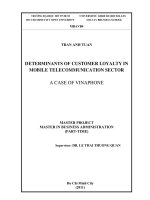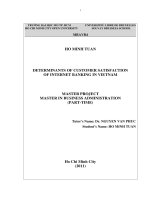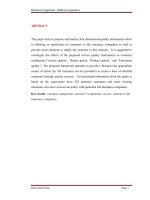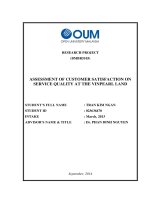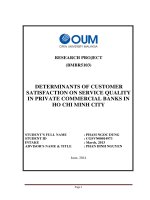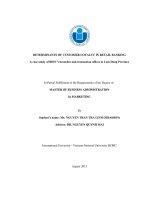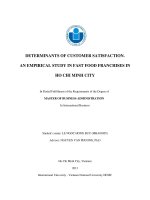Determinants of customer satisfaction on internet banking in Vietnam
Bạn đang xem bản rút gọn của tài liệu. Xem và tải ngay bản đầy đủ của tài liệu tại đây (2.19 MB, 61 trang )
i
TRƯỜNG ĐẠI HỌC MỞ TP. HCM UNIVERSITEÙ LIBRE DE BRUXELLES
HO CHI MINH CITY OPEN UNIVERSITY SOLVAY BRUSSELS SCHOOL
MBAVB4
HO MINH TUAN
DETERMINANTS OF CUSTOMER SATISFACTION
OF INTERNET BANKING IN VIETNAM
MASTER PROJECT
MASTER IN BUSINESS ADMINISTRATION
(PART-TIME)
Tutor’s Name: Dr. NGUYEN VAN PHUC
Student’s Name: HO MINH TUAN
Ho Chi Minh City
(2011)
ii
COMMITMENT
I hereby committed that the thesis content was prepared and written by myself with
information obtained from reliable sources for the partial fulfillment of the requirement for
the degree of Master in Business Administration program.
HoChiMinh City, December, 2011
HO MINH TUAN
iii
ACKNOWLEDGEMENT
First of all, I would like to express my deepest gratitude to Dr. NGUYEN VAN PHUC
who gave me a lot of valuable comments and guidance during this thesis.
Secondly, I would like to express my sincere acknowledgement to Belgian professors from
Solvay Brussels School of Economics and Management who taught me not only valuable
knowledge and experiences on business administration but also analytical, creative
thinking and professional working methods.
Thirdly, I would like to appreciate all Vietnamese professors from Ho Chi Minh City Open
University who transfer me knowledge, experiences and spirit which guided me during this
program.
Fourthly, I would like to thank Mr. Serge Bywalski, Ms. Hien and Ms. Ha – program
coordinators - for their support on schedule planning, academic procedure and extra-
courses tutoring.
Next, I would like to thank my team members and classmates who studied together during
two years, contributed innovative ideas, shared experiences and developed close
friendship.
Finally, I would like to express love to my parents and younger sister who have
encouraged and motivated me during the program.
v
ABSTRACT
Internet banking is a new channel of banking services which have a lot of benefits against
other traditional channels. It allows customers to perform a wide range of banking services
electronically via banks’ websites. It helps customers to enjoy their financial services not
only anywhere, anytime but also faster and more efficient.
Internet banking becomes a key and strategic component of every bank nowadays but its
customers remain very modest. Both customer development and customer retention are
much focused. Customer development takes considerably more time and cost because
other potential Vietnamese customers have low level of income, less knowledge to use
Internet and long time habit of cash transaction. Therefore, customer retention strategy is
more preferable by improving level of customer satisfaction. This research is to find key
determinants of customer satisfaction of Internet banking in Vietnam and to propose
strategic recommendations for banks to increase customer satisfaction level and then to
succeed in their customer retention.
About findings of the study, the three most important determinants of customer satisfaction
of Internet banking are convenience, image, security and website content (security and
website content have the same important level). In turn, key determinants of convenience
are enabling customers to make their transaction at anytime and anywhere. Key
determinants of security are certification from a famous international institution and
available 24/24 hot-line for any queries. Key determinants of website content are
accessible at anytime, each transaction performs fast and having confirmation notice. Key
determinants of customer support are fast, free hot-line available for any queries, collection
of regular feedback from customers and consulting the reason and solution for future
experiences. Key determinants of promotion are higher saving interest rate and discounts
for eating, shopping, tourism at some specific partnership stores. Key determinants of
image are modern and dynamic.
Keywords: Vietnam, Internet banking, customer satisfaction, determinants.
vi
TABLE OF CONTENT
COMMITMENT ii
ACKNOWLEDGEMENT iii
TUTOR’S COMMENT iv
ABSTRACT v
TABLE OF CONTENT vi
ABBREVIATION ix
LIST OF FIGURES x
LIST OF TABLES xi
CHAPTER 1: INTRODUCTION TO THE STUDY 1
1.1 Rationale of the study 1
1.2 Problem statement 2
1.3 Research objectives and questions 2
1.4 Significance and scope of the study 2
1.5 Research methodology 2
1.6 Structure of the study 3
CHAPTER 2: LITERATURE REVIEW 4
2.1 Customer satisfaction 4
2.2 Service quality and Website quality 6
2.3 Research model 8
2.4 Internet banking 10
2.4.1 History of Internet banking 10
2.4.2 Definition of Internet banking 11
2.4.3 Security method 11
vii
2.4.4 The architecture of Internet banking 12
2.4.5 The advantages and disadvantages of Internet banking 14
2.4.6 The current situation of Internet banking in the World 15
2.4.7 The development of Internet banking in Vietnam 17
CHAPTER 3: RESEARCH METHODOLOGY 20
3.1 Type of research 20
3.2 Research design 21
3.3 Target population 24
3.4 Sample size 24
3.5 Questionnaire design 24
3.6 Data collection 25
CHAPTER 4: DATA ANALYSIS AND FINDINGS 26
4.1 Profile information of respondents 26
4.2 Usage volume of current and potential products 28
4.3 Determinants of customer satisfaction 29
4.4 Determinants of each customer satisfaction factor 32
4.4.1 Determinants of convenience 32
4.4.2 Determinants of security 33
4.4.3 Determinants of website content 35
4.4.4 Determinants of customer support 36
4.4.5 Determinants of promotion 38
4.4.6 Determinants of image 39
CHAPTER 5: CONCLUSION AND RECOMMENDATION 41
5.1 Conclusion 41
5.2 Recommendation for banks to improve their customer satisfaction 42
viii
Image building 42
Product development 42
5.3 Limitation of the study and future suggestion 43
REFERENCES 44
APPENDICES 46
ix
ABBREVIATION
ASEAN Association of Southeast Asian Nations
VNNIC Vietnam Internet Network Information Center
ACSI American Customer Satisfaction Index
CORE Centralized Online Real-time Exchange
ATM Automatic Teller Machine
SMS Short Message Service
PIN Personal Identification Number
TAN Transaction Identification Number
SSL Secure Socket Layer
VND Viet Nam Dong
SEC Social Economic Class
x
LIST OF FIGURES
Figure 1.6: The structure of the study 3
Figure 2.1.1: American Customer Satisfaction Index 5
Figure 2.1.2: Diagram of customer satisfaction factors 5
Figure 2.3: Variables development 8
Figure 2.4.4: The architecture of Internet banking 12
Figure 2.4.7.1: Internet users in Vietnam 2004 - 2010 16
Figure 2.4.7.2: Online business development 2007 - 2010 17
Figure 3.2.1: Research design 2
Figure 4.1.1: Gender distribution 25
Figure 4.1.2: Age group distribution 25
Figure 4.1.3: Distribution of educational level 26
Figure 4.1.4: Distribution of Internet banking usage frequency 26
Figure 4.2.1: Usage volume of current products 27
Figure 4.2.2: Usage volume of potential products 28
Figure 4.3: Customer satisfaction determinants 29
Figure 4.4.1: Determinants of convenience 31
Figure 4.4.2: Determinants of security 32
Figure 4.4.3: Determinants of website content 33
Figure 4.4.4: Determinants of customer support 34
Figure 4.4.5: Determinants of promotion 35
Figure 4.4.6: Determinants of image 36
xi
LIST OF TABLES
Table 2.2.1: Service quality dimensions 7
Table 2.2.2: Website quality dimensions 8
Table 3.1: Comparison between traditional and Internet survey method 20
Table 3.2.1: Variables coding 22
Table 4.3.1: T-test for customer satisfaction determinants 29
Table 4.3.2: T-test for Likert scale 29
Table 4.4.1: T-test for determinants of convenience 31
Table 4.4.2: T-test for determinants of security 32
Table 4.4.3: T-test for determinants of website content 33
Table 4.4.4: T-test for determinants of customer support 34
Table 4.4.5: T-test for determinants of promotion 35
Table 4.4.6: T-test for determinants of image 36
1
CHAPTER 1: INTRODUCTION TO THE STUDY
This chapter mentions the rationale of the study, problem statement, research objectives
and questions, significance and scope of the study, research methodology and structure of
the study.
1.1 Rationale of the study
Vietnamese Government has been investing heavily in Information Technology
infrastructure and Internet network for the country from the year 1997.With the advantage
of huge and young population (87 million people in which over 60% of them under the age
of 30) and high Internet penetration comparing to other ASEAN countries (26.8 millions of
Internet users representing for 31% of the population in 2010), Vietnam is very potential to
all kinds of Internet-based business and activities such as e-shopping, e-banking, e-
communication, e-entertainment, e-education, e-marketing, e-advertising, social
networks…
Banks have always been among the first to apply new technologies into their products,
services and management. Now, with many considerable developments in technology,
banks have more and more opportunities to serve customers beyond their satisfaction.
Beside traditional banking channels such as bank counter, phone, fax, mobile, ATM,
Internet is now used more widely all over the world as an amazing way to conduct banking
services at anytime, anywhere. Internet banking does help customers enjoy financial
services not only faster, more convenient, efficient but also security.
Many banks operating in Vietnam have recently launched new Internet banking service
which exploits the strength of Internet technology to bring more convenience and benefits
to customers. Unfortunately, the number of customers using this service is very modest
despite the high Internet penetration in Vietnam. Banks focus not only on getting new
customers but also on retaining their current customers. Getting new customers always cost
several times more than retaining them. Hence, customer retention is very important to
banks nowadays. This research is to find the most important satisfaction factors of Internet
banking and to propose some strategic recommendations for banks to help improve level of
customer satisfaction.
2
1.2 Problem statement
It is very important to satisfy and retain customers in Internet banking services because not
so many people used it in Vietnam. Higher customer satisfaction leads to higher customer
loyalty and retention. In turn, it ensures long-term profitability and growth. Therefore, this
research aims to propose recommendation for banks to improve customer satisfaction level
by finding the most important satisfaction factors of Internet banking in Vietnam.
1.3 Research objectives and questions
a) Research objectives
i. To identify key determinants of customer satisfaction of Internet banking in
Vietnam.
ii. To propose recommendations for banks to improve their customer
satisfaction.
b) Research questions
i. What are key determinants of customer satisfaction of Internet banking in
Vietnam?
1.4 Significance and scope of the study
Besides attracting new customers for Internet banking, banks are trying to keep their
current customers by improving their level of satisfaction. This study is to find the most
important satisfaction factors of Internet banking customers and to propose strategic
recommendation for banks. However, the study is limited to banks operating in Vietnam
and sample size is around 100 – 200 due to time and resource constraint.
1.5 Research methodology
The quantitative research is applied to measure customer satisfaction level of Internet
banking in Vietnam. In quantitative method, online survey is chosen because of its
convenience, flexibility and efficiency. Respondents of the survey are customers of
Internet banking who are currently use Internet banking channel at a bank, age from 18 –
50 and are living at big cities in Vietnam. For collected data from the survey, descriptive
analysis and T-test are used to identify the most important satisfaction factors which are
statistically significant of Internet banking in Vietnam.
3
The secondary data are also collected in form of figures and statistics from Government’s
General Office of Statistics, financial institutions and some market research agencies.
1.6 Structure of the study
This research is structured into five chapters. Chapter 1 introduces the research including
rationale of the study, research problem, research objectives, research questions and
methodology. Chapter 2 provides a literature review of Internet banking and customer
satisfaction factors. Chapter 3 discusses the methodology and design of the research.
Chapter 4 analyzes the collected data and presents findings of the research. Chapter 5
makes recommendations and conclusion.
Figure 1.6: The structure of the study
Chapter 2: Literature Review
Chapter 1: Introduction to the study
Chapter 3: Research Methodology
Chapter 4: Data Analysis and Findings
Chapter 5: Conclusion and Recommendation
4
CHAPTER 2: LITERATURE REVIEW
In this chapter, literature about customer satisfaction, service quality, website quality and
Internet banking are reviewed.
2.1 Customer satisfaction
Customer satisfaction of products or services is often seen as key factor to the long-term
success of a company because it influences on customer loyalty, retention and new
customers development as well.
Customer satisfaction with a purchase depends upon the product’s performance relative to
a buyer’s expectations; a customer might experience various degrees of satisfaction. If the
product’s performance falls short of expectations, the customer is dissatisfied. If the
performance matches the expectations, the customer is satisfied. If the performance
exceeds the expectations, the customer is highly satisfied or delighted (Kotler. P,
Amstrong. G, Saunders. J, Won. V, 2001).
There is variety of definitions of customer satisfaction. Hunt (1977) described satisfaction
as “an evaluation of an emotion”, suggesting that it reflects the degree to which a consumer
believes that the possession and/or use of a service evokes positive feelings (Rust and
Oliver, 1994). Customer satisfaction can be defined as an evaluative response or outcome
of the product purchase and consumption experience resulting from a comparison of what
was expected and what was received (Patterson, 1993).
Some customer satisfaction factors have been developed in the American Customer
Satisfaction Index (ACSI) model by the University of Michigan’s Ross School of
Business. The ACSI is cause and effect model with indices for factors of satisfaction
(customer expectations, perceived quality and perceived value), satisfaction itself and
outcomes of satisfaction (customer complaint, customer loyalty).
5
Figure 2.1.1: American Customer Satisfaction Index
Source: Michigan’s Ross School of Business (
In addition to perceived quality and customer expectation factors, other satisfaction factors
have also been developed:
Figure 2.1.2: Diagram of customer satisfaction factors
Source:
www.articlefolder.net
6
2.2 Service quality and Website quality
Many researchers have used service quality as a factor impacting on customer satisfaction
(Parasuraman et al., 1988). Parasuraman (1985) proposed ten dimensions to measure the
quality of services: reliability, responsiveness, competence, access, courtesy,
communication, credibility, security, understanding the customers and tangibles.
1. Reliability means that the firm performs the service right in the first time and
honors its promises: accuracy in billing, keeping records correctly, performing the
service at promised quality on time…
2. Responsiveness concerns the willingness, readiness and timeliness of employees to
provide service: giving quick answer, prompt service…
3. Competence means possession of the required skills and knowledge to perform the
service.
4. Access involves approachability and ease of contact to the service.
5. Courtesy involves politeness, respect, consideration and friendliness of contact
personnel (receptionists, telephone operators, sales forces).
6. Communication means keeping customers informed in language they can
understand and listen to them. For example, the firm should increase level of
sophistication with a well-educated customer and speaking plainly with a less-
educated people.
7. Credibility concerns trustworthiness, believability and honesty.
8. Security is the freedom from danger, risk or doubt: physical safety, financial
security and information confidentiality.
9. Understanding the customer involves making efforts to understand customers’
needs: understanding customers’ demand, recognizing regular customers, offering
customized options…
10. Tangibles include the physical evidence of the service: physical facilities,
appearance of personnel, physical representation of the service, tools or
equipment…
After that in 1988, he reduced these ten dimensions to five attributes by using factor
analysis: tangible, reliability, responsiveness, assurance and empathy. Based on the five
7
dimensions, 22-item survey instruments called SERVQUAL was used to measure service
quality and was applied widely. MinJoon. J and Shaohan. C(2009) proposed ten
dimensions to assess Internet banking service quality: reliability, responsiveness,
competence, courtesy, credibility, access, communication, understanding customers,
collaboration and continuous improvement. The first eight dimensions were previously
uncovered by Parasuraman et al. (1985), the remaining two dimensions were uniquely
developed by Minjoon. J and Shaohan. C (2009).
Table 2.2.1: Service quality dimensions
Liu and Arnett (2000) mentioned four factors to evaluate website quality: system use,
system design quality and playfulness. Barnes and Vidgen (2000) proposed other four
factors: functionality, content, service and attractor. Jayawardhena and Foley (2000)
suggested that to enhance customer satisfaction from Internet banking, the speed of
download, content, design, interactivity, navigation and security are critical to assess
8
Internet banking website. Minjoon. J and Shaohan. C(2009) proposed six dimensions to
assess Internet quality as following:
Table 2.2.2: Website quality dimensions
2.3 Research model
The research framework of this study is adapted mainly from studies of Parasuraman
(1985) about service quality and Minjoon. J and Shaohan. C(2009) about website quality.
Moreover, 2 variables (promotion and image) are added to reflect the emotional
satisfaction and promotion power in the Vietnamese Internet banking context.
Figure 2.3: Variables development
Convenience
Customer
satisfaction
Promotion
Image
Security
Website content
Customer support
9
- Convenience: with Internet banking, customers can make their transactions at any time, at
any where, at great speed. It is no doubt that convenience is one of the key benefits
outstanding from many other traditional banking channels. It was also researched by
Parasuraman (1985) under the variable named “Access” in the study of service quality.
Therefore, it would be convincing to put convenience in set of key satisfaction factors and
be measured by this study.
- Security: although convenience is the most influential factor, it becomes dangerous if
security is not ensured. People might not use Internet banking service without security in
spite of great convenience. They tend to be concerned about losing their private and
sensitive data. They are also uncertain about hackers, frauds. This factor was measured by
Parasuraman (1985) and became popular in online business world. It would be necessary to
add security to key satisfaction factors of Internet banking service in Vietnam.
- Website content: is very important because it is the direct mean to make online tractions
with Internet banking. This factor was also investigated by Minjoon. J and Shaohan. C
(2009). It would be necessary to ask whether website content is one of Vietnamese
customer satisfaction factor and the importance level of it comparing to other variables.
- Customer support: customer support plays a vital role in Internet banking service because
it is the only human contact of the service package. And human “touches” human in a
natural but deepest way. Customer support involves in two variables “communication” and
“responsiveness” in the study of Parasuraman (1985) about service quality. It would be
interesting to know how much customer support contributes to the level of customer
satisfaction of Vietnamese Internet banking.
- Promotion: price is one of key components in buying a product or service. People tend to
buy at cheaper price with the same quality of products. Promotion is one way of
discounting price. It is no doubt that higher promotion is among satisfaction factor of
Internet banking customers. Hence, it would be interesting to know how important it is
when comparing to the other satisfaction factors. Promotion was mentioned by Philip
Kotler (2001) and in many other researches.
10
- Image: besides functional values of a product or service, many people pay attention to
psychological values such as reputation of product’s brand, the lifestyle and image in
which a product represents…They tend to choose products or services which have the
image that is similar to their own image or the one they are following. When using Internet
banking services, many people feel that they are more modern, dynamic and professional.
Consequently, it would be more interesting to check whether the variable of image plays
an important part in satisfaction factors of Internet banking customers. The concept of
image was mentioned by Philip Kolter (2001) and in many other researches as well.
2.4 Internet banking
2.4.1 History of Internet banking
The previous version of today’s online banking services was the distance banking services
over electronic media from the early 1980s. Online banking services started in New York
in 1981 when four of the city’s major banks (Citibank, Chase Manhattan, Chemical and
Manufacturers Hanover) offered home banking services. Because of lack of commercial
success, these banking services never became popular. Stanford Federal Credit Union was
the first financial institution to offer online internet banking services to all of its members
in October 1994. The revolution then spread to the world and brought huge benefit for
banks and customers. When first introduced, Internet banking was used mainly as an
information presentation mean where banks marketed their products and services on their
websites. With the development of asynchronous technologies and secured electronic
transaction technologies, more banks have come forward to use Internet banking both as a
transactional and an informational mean. As a result, registered Internet banking users can
now perform common banking transactions such as writing checks, paying bills,
transferring funds, printing statements, and inquiring account balances. Internet banking
has evolved into a “one stop service and information unit” that promises great benefits to
both banks and consumers.
11
2.4.2 Definition of Internet banking
Internet banking is the use of the Internet as a delivery channel for banking services,
allowing customers to perform a wide range of banking transactions electronically via the
bank’s website. Internet banking can be categorized broadly into three levels:
- The Basic Level: presenting information on different products and services offered to
customers. It may receive and reply to customers’ queries through email.
- Simple Transactional: allowing customers to submit their instructions, applications for
different services, queries on their account balances etc, but do not permit any fund-based
transactions on their accounts.
- Fully Transactional: allowing the customers to operate on their accounts for transfer of
funds, payment of different bills, subscribing to other products of the bank and to transact
purchase and sale of securities, etc. Some of these banks are known as “virtual” banks or
“Internet only” banks as not have any physical presence but offering different banking
services.
2.4.3 Security method
The popular security methods for Internet banking is the PIN/TAN (Personal Identification
Number/Transaction Identification Number) system where the PIN represents a password,
used for the login and TANs representing one-time passwords to authenticate transactions.
TANs can be distributed in different ways. The most popular one is to send a list of TANs
to Internet banking customers by postal letter. The most secure way of using TANs is to
offer customers a security token to generate passwords. These token generated TANs
depend on the time and a unique secret stored in the security token. Usually online banking
with PIN/TAN is done via a web browser using SSL secured connections, so that there is
no additional encryption needed. Another way to provide TANs to an Internet banking user
is to send the TAN of the current bank transaction to the user's mobile phone via SMS. The
SMS text usually quotes the transaction amount, transaction details and the TAN which is
only valid for a short period of time.
12
2.4.4 The architecture of Internet banking
Most banks use core banking applications to support their operations where CORE stands
for "centralized online real-time exchange". This basically means that all branches of the
bank access applications from centralized datacenters. The deposits made are reflected
immediately on the bank's main servers and the customer can withdraw the deposited
money from any of the bank's branches throughout the world. Normal core banking
functions will include deposit accounts, loans, mortgages and payments across multiple
channels like ATMs, Internet banking, and bank counters.
Core banking system is a back-end system that processes daily banking transactions, and
posts updates to accounts and other financial records. Core banking systems typically
include deposit, loan and credit-processing capabilities, with interfaces to general ledger
systems and reporting tools. Strategic spending on these systems is based on a combination
of service-oriented architecture and supporting technologies that create extensible, agile
architectures.
13
Figure 2.4.4: The architecture of Internet banking
Source: Artifactory Open Source (www.jfrog.com)
A computer application is typically separated into three main tasks: interaction with the
user, processing of transactions according to business rules and storage of business data.
The three tasks can be viewed as three layers, which may run on the same system or may
be separated on to multiple computers leading to three-tier architecture. These layers can
be briefly described as follows:
(1) Presentation Layer: This layer is responsible for managing the front-end devices, which
include browsers on personal computers, Personal Digital Assistants (PDAs), mobile
phones, Internet kiosks, Web TV etc. The presentation layer takes care of user interface
issues like displaying format, color, layout, image etc. It also has important responsibilities
in user authentication and session management activity.
14
(2) Application layer: It contains the business logic for processing of data and transactions
and necessary interfaces to the data layer. It processes requests from the presentation layer,
connects to the data layer, receives and processes the information and passes results back
to the presentation layer. It is responsible for ensuring that all the business rules are
incorporated in the software. The issues of scalability, reliability and performance of the
services to a great extent depend upon the application layer architecture.
(3) Data Layer: The data layer uses database to store, retrieve and update application data.
The database may be maintained on one or multiple servers. The database also supports
back-up and recovery of data as well as logging of all transactions.
2.4.5 The advantages and disadvantages of Internet banking
A - The advantages of Internet banking
• Anytime services: customers can use banking services 24 hours a day, and seven
days a week, not limited to working hours. They can even instruct a transaction
which will happen at a specific time later.
• Anywhere services: customers can use banking services at their home, office, in a
café shop or anywhere as long as they can access to the Internet. Nowadays, with
the support of 3G wave technology, Internet banking is available everywhere for
customers.
• Worldwide market: since websites can reach the people as far as the Internet does,
the people from every corner of the globe are now potential customers. The market
is now worldwide for banks.
• Transactional speed: electronic information can travel from place to place in a
matter of seconds or less. Waiting time for administrative process can be eliminated
remarkably by the use of Internet.
• Latest information: customers can access the latest information from bank’s
website instead of slower traditional methods like mail, telephone
• More transactional space: not so many customers can conduct banking services at
the same time in the same branch. With the strength of Internet, banks can serve
thousands of customers at the same time.
15
• More customers understanding: banks can extract valuable knowledge from
analyzing automatically-collected customer behaviors when they conduct
transactions. With this business intelligence, banks understanding customers more.
• More cost-saving: cost to acquire a new customer decreases in long-term
perspective according to many researches.
B - The disadvantages of Internet banking
• Risk of privacy exposure: customers’ information might be exposed and they might
get annoying advertising messages.
• Risk of transaction security: banks are using more secure algorithm to protect
transactional security from hackers.
• Requirement of website experience: some customers might find it difficult to
transactional website if they have little experience on website usage. Banks
understand and support their customers by giving visual aid, guideline, frequently
asked questions and live support.
• Big investment: a lot of time, effort and capital have been invested for Internet
banking system. But it is the critical success factor for banks in the long-term and
worth implemented.
2.4.6 The current situation of Internet banking in the World
In the United State, approximately 78% of all commercial banks with more than $5 billion
in assets have transactional websites, while 43% of banks with $500 million to $5 billion in
assets and 10% of banks under $500 million in assets have transactional websites. Many
new business process and technological advances such as Electronic Bill Presentment and
Payment, handheld access devices such as Personal Digital Assistants, Internet Telephone
and Wireless Communication channels are used in the United State banking sector.
Over two thirds of United Kingdom consumers conducting the majority of their banking
activities on the internet in 2006, compared to one in five in 2005, according to Lloyds
TSB. In addition, 57% of the people surveyed said that they banked via the internet more
often recently.
